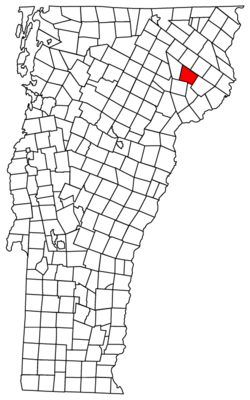Burke, Vermont facts for kids
Quick facts for kids
Burke, Vermont
|
|
|---|---|

|
|

Burke, Vermont
|
|
| Country | United States |
| State | Vermont |
| County | Caledonia |
| Chartered | 1782 |
| Settled | 1790 |
| Organized | 1796 |
| Communities | East Burke West Burke Burke Hollow |
| Area | |
| • Total | 34.0 sq mi (88.1 km2) |
| • Land | 33.9 sq mi (87.8 km2) |
| • Water | 0.2 sq mi (0.4 km2) |
| Elevation | 1,027 ft (313 m) |
| Population
(2020)
|
|
| • Total | 1,651 |
| • Density | 49/sq mi (18.8/km2) |
| Time zone | UTC-5 (Eastern (EST)) |
| • Summer (DST) | UTC-4 (EDT) |
| ZIP codes | |
| Area code(s) | 802 |
| FIPS code | 50-10450 |
| GNIS feature ID | 1462059 |
Burke is a small town located in Caledonia County, Vermont, in the United States. In 2020, about 1,651 people lived here. The town includes a few smaller areas like East Burke, West Burke, and Burke Hollow. It's famous for Burke Mountain and the Burke Mountain Academy.
Contents
What's in a Name?
The town of Burke was named after Sir Edmund Burke. He was an important member of the English Parliament a long time ago.
Exploring Burke's Geography
Burke covers an area of about 88.1 square kilometers (or 34 square miles). Most of this area, 87.8 square kilometers, is land. Only a small part, about 0.4 square kilometers, is water.
Burke shares its borders with several other towns. To the south, you'll find Lyndon and Kirby. Victory is to the southeast, and East Haven is to the northeast. To the north is Newark, and to the west is Sutton.
Main roads like U.S. Route 5 and Vermont Route 114 help people travel through Burke. U.S. Route 5 connects Burke to towns like Lyndonville and Barton. Vermont Route 5A also starts in West Burke and goes north towards Lake Willoughby.
The highest point in town is Burke Mountain. It stands tall at about 997 meters (or 3,271 feet).
Burke's Climate
Burke experiences a warm-summer humid continental climate. This means it has warm summers and cold, snowy winters.
The hottest temperature ever recorded in Burke was 98°F (37°C) on July 19, 1953. The coldest temperature was a chilly -41°F (-41°C) on February 2–3, 1962.
Who Lives in Burke?
| Historical population | |||
|---|---|---|---|
| Census | Pop. | %± | |
| 1800 | 108 | — | |
| 1810 | 460 | 325.9% | |
| 1820 | 541 | 17.6% | |
| 1830 | 866 | 60.1% | |
| 1840 | 997 | 15.1% | |
| 1850 | 1,103 | 10.6% | |
| 1860 | 1,138 | 3.2% | |
| 1870 | 1,162 | 2.1% | |
| 1880 | 1,252 | 7.7% | |
| 1890 | 1,198 | −4.3% | |
| 1900 | 1,184 | −1.2% | |
| 1910 | 1,183 | −0.1% | |
| 1920 | 1,041 | −12.0% | |
| 1930 | 1,016 | −2.4% | |
| 1940 | 998 | −1.8% | |
| 1950 | 1,042 | 4.4% | |
| 1960 | 922 | −11.5% | |
| 1970 | 1,053 | 14.2% | |
| 1980 | 1,385 | 31.5% | |
| 1990 | 1,406 | 1.5% | |
| 2000 | 1,571 | 11.7% | |
| 2010 | 1,753 | 11.6% | |
| 2020 | 1,651 | −5.8% | |
| U.S. Decennial Census | |||
In 2000, there were 1,571 people living in Burke. Most of the people living in Burke were White (about 97%). A small number of people were from other racial backgrounds.
About 30% of the households in Burke had children under 18 living there. Many families were married couples living together. The average household had about 2.45 people.
The population in Burke includes people of all ages. About 23.6% were under 18, and 11.4% were 65 or older. The average age in town was 39 years old.
Burke's Economy
The average income for a household in Burke in 2000 was about $35,268 per year. For families, the average income was around $41,563. About 13.9% of the people in Burke lived below the poverty line.
Fun and Tourism in Burke
Burke Mountain is a big draw for visitors. It's home to the Burke Mountain Resort. In winter, people come here for skiing and snowboarding. In summer, it's a popular spot for downhill mountain biking.
The resort also has a hotel with a pool, restaurants, and an arcade. It's a great place for events like weddings. Burke Mountain is also home to the Burke Mountain Academy, a top school for ski athletes.
East Burke is famous for its Kingdom Trails system. These trails are very popular with mountain bikers, especially in the summer and fall. Hundreds of riders visit the trails at once.
The town is also close to beautiful lakes like Willoughby and Crystal Lake. The mountains around them, Mount Hor and Mount Pisgah, attract people who enjoy swimming and hiking.
Famous People from Burke
- Henrietta A. Bingham (1841–1877) was a writer, editor, and teacher.
- John Q. Farmer (1823-1904) was a state legislator in Minnesota.
- Buddy Jones (1937–2014) was a Bluegrass musician. He lived in West Burke for many years.
- Charles Albert Woodruff (1845–1920) was a US Army brigadier general. He was born in Burke.
See also
 In Spanish: Burke (Vermont) para niños
In Spanish: Burke (Vermont) para niños


